Have you ever stepped into a room and heard the resonant, sweet harmony of a 12-string guitar? I recall the moment when the strings of my first Guild 12-string acoustic guitar vibrated under my touch; its sound swelled around me, painting the air with melodious chords, and I knew my musical journey was irrevocably changed. But how did this Guild guitar, of all the guitars I’ve known, make such a profound shift in my music experience? Hold your curiosity tight, as we navigate through this sonic revelation together.
I’m Robert Williams, a seasoned guitar journalist, who, over the years, has scrutinized an endless array of guitars. Despite my extensive guitar knowledge, it was that particular Guild 12-string acoustic that really fascinated me. With each strum, this instrument fosters a unique connection, generating something that’s more than sound—it’s an experiential masterpiece. Ready to unravel the secrets of Guild 12-string acoustics with me? Keep reading.
Note: This is not just a dry comparison of Guild’s 12-string models—this piece is a tribute, a love letter, even a deep dive into what makes these instruments transcend the ordinary. Shall we?
Exploring the Guild 12-string Acoustic Guitar
History & Construction
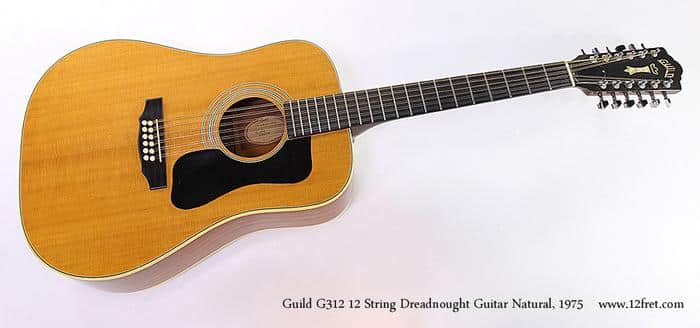
Carrying forward our exploration of the captivating Guild 12-string acoustic guitar, let’s delve into the enriching realms of its history and construction. As someone who has inspected and reviewed an endless number of Guild guitars, I can assure you of the mesmerizing craftsmanship behind their making.
Guild guitar history starts back in 1952, with a vision of crafting high-quality, handmade instruments. Guild’s consideration for the fine details, its commitment to quality, and the utilization of only premium materials has been the pillars sustaining its legacy.
Taking a closer look at Guild guitar construction, I am often struck by the intricate blend of traditional techniques with cutting-edge technology. Hand-carved braces and dovetail neck joints speak to the intensive labor and unmatched skill deployed in their making. Even the woods selected for each guitar, from the back and sides to the top and neck, are chosen with precise intentionality, resulting in a tonally rich and visually stunning instrument.
The Guild 12-string acoustic guitar, in particular, is a testament to this meticulous craftsmanship. The design and construction of each component — from the specially designed bridge to the dual-truss rod in the neck — ensures that these guitars carry a distinctive voice and avoid the common structural issues found in many 12-string guitars.
This deep dive into the history and construction of Guild guitars effectively illuminates the guitar’s structural integrity and its rich provenance. The immersive journey of discovery engrained in each finely crafted Guild 12-string acoustic guitar extends far beyond the mere sound it produces, enhancing the tactile and emotional connection between musician and instrument.
Moving forward, we will continue examining the myriad features and stunning playability that puts Guild guitars in a league of their own. My hope is to provide you a nuanced understanding of these qualities, to refine your appreciation and discernment as a passionate guitarist.
Features & Playability
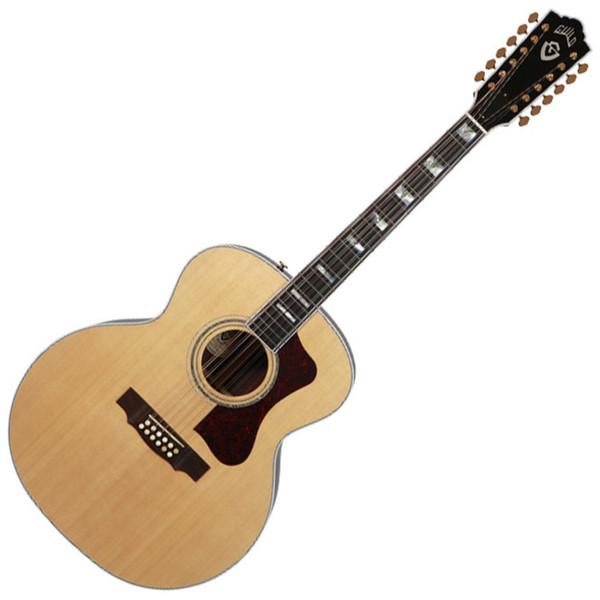
Having delved into the history and construction of Guild 12-string acoustic guitars, the conversation naturally evolves to a discussion of the distinctive features and unique playability of these instruments. My experience, whether playing delicate fingerpicking melodies or intense chord progressions, has allowed me to appreciate the remarkable qualities these guitars offer.
One of the defining Guild guitar features I want to highlight are the dual-action truss rods. Unlike traditional single action rods, these dual-action truss rods allow for adjustment in both directions, thus providing more precise control over the neck’s relief. This results in a guitar neck adjusting to different styles of play and string tensions effectively, lending the Guild 12-string guitars their renowned versatility and reliability.
Speaking of versatility, what sets the Guild 12-string apart for me is its impressive playability. The Guild 12-string playability extends beyond a well-constructed neck or quality wood. It is the perfect harmony of all elements that makes up this instrument. These guitars are designed for comfort, enabling the guitarist to reach all twelve strings with ease. This ergonomically crafted instrument promotes an effortless transition from strumming to fingerpicking, permitting musicians to experiment freely with diverse genres and techniques.
Guild 12-strings are also known for their wide necks and generous string spacing. While this may seem daunting to some players, I found that the wider neck, coupled with the well-proportioned spacing, allows the fingers to move freely without the dreaded string buzz. It also encourages clean textured harmonics – a sought-after feature in any 12-string acoustic guitar.
The playability of these guitars is further amplified by the Guild’s traditional choice of a rosewood fingerboard, known for its smooth playability and warm tones. Prepared to be pleasantly surprised by how these considerations interact with your playing style, inviting you to explore new musical possibilities.
In conclusion, the distinct features of Guild 12-string guitars, such as the dual-action truss rods, coupled with their exceptional playability, make them a truly remarkable instrument. However, while these features undoubtedly contribute to the identity of Guild 12-string guitars, the complete picture isn’t drawn until we dive into the topic of sound quality, which would be our next area of focus in this exploration.
Sound Quality of Guild 12-string Guitars
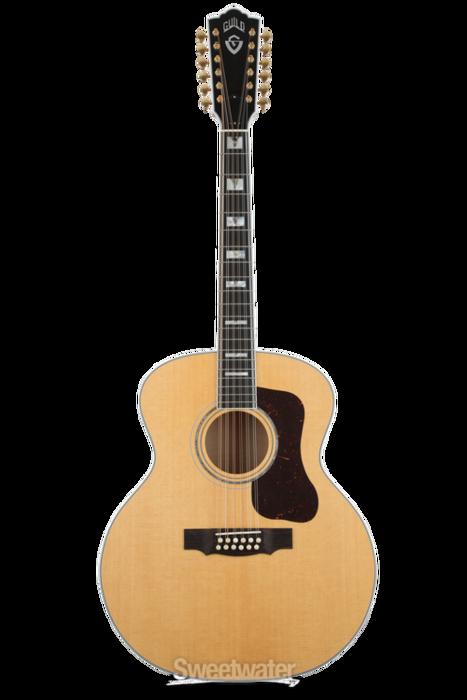
As I delve into the pivotal chapter on ‘Sound Quality of Guild 12-string Guitars’, my trained ear for music, my long-standing affair with guitars, and my close association with the Guild brand will guide us. In the landscape of 12-string acoustic guitars, Guild holds a special significance for me; they’re like the ultimate midsummer’s sonnet that eloquently weaves an enchanting melody.
Nestled amidst this musical realm is a salient question that has been tickling my curiosity for quite some time now: Is it possible that a Guild 12-string guitar produces a sound quality unlike any other in its league?
As I coax this query out from the recesses of my musically charged brain, my hands instinctively reach for the Guild F-512, known for its rich and vibrant tonal color. A gentle strum sends a tidal wave of colour through the air; a symphony of tones and harmonics that never fails to tug at my heartstrings. The fullness of its song, the deep resonance, and that sublime harmonic bloom contribute to a feeling of profound immersion. The Guild 12-string sound quality, I must admit, is truly in a class of its own.
For me, the Guild 12-string guitars have carved their own identity in the sea of acoustic strummers, thanks to their unique sonic signature. A melange of warm undertones and sweet resonance, it serenades my senses and leaves me hankering for more. Yet, it’s the delicate balance of tonal facets and the subtle interplay of overtones that truly elevate the Guild 12-string guitar’s distinguishing nuance. It caresses the frequencies—both high and low—with an effortless charm that I find irreplaceable.
Of course, it’s not just about the sound it produces, but how it corroborates the player’s intent. The way it responds to the touch, the manner in which it translates the intensity or softness of the strum into sound, adds another dimension to the Guild 12-string sound quality. Every Guild 12-string guitar seems to have its own voice, its own distinct personality. And yet, they all speak the same language of excellent sound quality.
However, attributing its distinctive sound entirely to its tonal characteristics would do it an injustice. In my experience, the construction and materials used in these guitars contribute as much to the perception of their sound as the nuances that we guitarists wax lyrical about. As an artist must understand his palette before painting a masterpiece, we must appreciate the influence of the guitar’s build on its final sound output.
In conclusion, the allure of a Guild 12-string acoustic guitar, particularly its exceptional sound quality, is not a matter of personal bias. With each pluck of a string and each chord strummed, the guitar pours out its soul, and we become inextricably linked to its melody. But don’t just take my word for it, experience the harmonious symphony of a Guild 12-string guitar yourself and let your own senses be the judge.
Coming up next, we’ll be delving deeper into different Guild 12-string models and witness how they match up against each other, so stay tuned!
Guild 12-String Guitar Models Comparison

One could ask; do certain Guild 12-string models outshine others and why? To answer this in one sweeping statement would be a disservice to the beautiful range of acoustics Guild has to offer. Each of their 12-string guitars I’ve encountered over the years has its own unique vibe and charm. Yet, among the vast selection, certain models do resonate with me more deeply than others. Specifically, the best Guild 12-string models according to my tastes are simply some of the most incredible guitars to grace my hands.
Consider, for instance, the Guild F-2512E Maple. This acoustic-electric 12-string guitar is a real treasure. Its beautifully robust sound is a treat for the ears, and the pleasure to strum or pluck is unparalleled. It’s an ideal choice for players looking for an instrument that can handle intense strumming and intricate fingerpicking alike, without compromising on tonal fidelity. Truly, the F-2512E Maple is a testimony to Guild’s utter commitment to quality craftsmanship.
One of the distinguishing features of the F-2512E Maple is its beaming, bright, and assertive tonal quality owing to its maple construction. The highlights of this guitar are its smooth, C-shape neck that feels comfortable underhand, the luxury of an inbuilt pickup for amplified performances, and of course, that majestic Guild sound. It’s this sound – rich, full-bodied, and lush – that sets it apart from its peers and wins my heart every time.
But what about the old vs new Guild 12-string guitar models? Is there a difference? For sure, the old Guild models are wrapped in nostalgia, with their unique, vintage tonal characteristics, whereas the modern iterations, like the aforementioned F-2512E Maple, combine classic Guild tonality with cutting-edge advances in guitar making technology. Yet, when it comes to sound and feel, it becomes mostly a matter of personal preference. I’ve played vintage Guild 12-string models that blew me away, just as I’ve been equally charmed by their modern counterparts.
This leads me to underline that there’s a delicate and personal connection between a guitarist and their instrument. What works for me may strike a very different chord with you. Therefore, I encourage you to explore a variety of Guild 12-string models, both old and new, to find the one that resonates with you the most.
In summary, while models like the F-2512E Maple tend to top my list of the best Guild 12-string guitars, what truly matters is the match between you, your playing style, and the guitar. The Guild 12-string models offer an impressive range in sound, feel, and aesthetics, making it possible for any discerning guitarist to find their perfect fit. Having had the privilege of playing many such models, I can tell you, few experiences compare to finding the Guild 12-string that sings in harmony with your soul.
So, is there an outright winner in this comparison? Not necessarily. But there’s certainly a Guild 12-string guitar that’s the perfect match for you. Stay tuned as we dive further into the structural considerations and continued evolution of Guild guitars, offering a detailed breakdown of what makes each model unique and how they stack up against other brands in the market.
Guild vs Other Brands
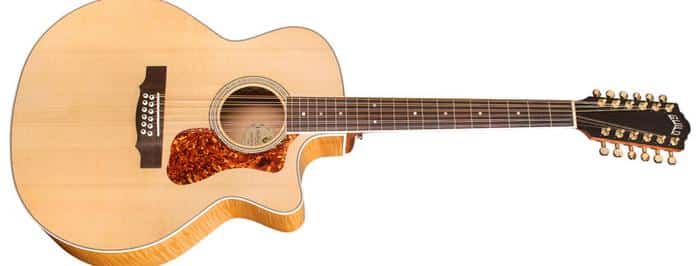
In my time as a music lover and guitarist, I’ve had the privilege of experiencing a wide range of guitar brands, particularly Taylor, Martin, and Guild – each of which exudes its brand brilliance in its own way. The passion and individuality of every guitar brand I’ve come across make the exploration endless, a journey marked with highs and surprising discoveries. The time has now come for a specific, comprehensive comparison. And the question that stands tall is – How do Guild 12-string guitars hold their ground when compared with powerhouses like Taylor or Martin?
As we dive into the dynamics of an acoustic guitar comparison, let’s focus our attention on Guild 12-string guitars and their competitors. For those who eagerly await my take on Guild vs Taylor 12-string guitars, let me start off by expressing my absolute concern for the guitar’s tonewood. Taylor often casts a bright, glossy sound that moves into a spectrum of buttery mids and chirping highs with their globally sourced woods. Meanwhile, Guild sustains a mellower resonance, which rises to a full-bodied volume – a result of their use of high-grade Sitka spruce tops and mahogany back and sides. In this perspective, you might say Guild offers a well-rounded, matured guitar tone whilst Taylor prefers a more vibrant, sparkly timber. Both equally amazing in their own respects, they do offer a different kind of pleasure to different kinds of guitar enthusiasts.
Moving towards Guild vs Martin 12-string guitars, I’ve learned that the meticulous attention to detail greatly influences the overall playability. Martin is often synonymous with their signature dreadnought body, which some players find uncomfortable for its larger size. On contrast, Guild offers several body sizes among their 12-string models; my personal favorite being the comfortable orchestra body found on the F-512. It is easier to cradle and doesn’t compromise on the full tonal capabilities, thereby ensuring an easy and enriching playing experience. Besides, this blond-beauty-of-a-guitar gives a nod to traditional craftsmanship and that hits a sentimental tone with seasoned players like myself.
When cornering down the final deciding factors, you must shuffle the key elements – affordability, aesthetics, and playability. Taylor’s guitars are often on the higher end of the pricing spectrum which might be a hurdle for many. Meanwhile, Martin secures its comfort zone with traditional aesthetic elements that stay true to classical guitar lovers. Guild, in my opinion, snags a middle ground in terms of pricing, and with their range of designs, they stand apart with an endearing uniqueness.
Each brand caters to its own audience, criticizing one for another is not fair play, and respect for diversity keeps the musical sphere harmonious. Exploring the uniqueness, individual beauty, and catering to personal preferences enhance the play and consequent love for music. None of these brands are inherently ‘better’; they symbolize individual choices and stand as products of refined preferences.
The guitar world is remarkably diverse and subjective. The essence of Guild 12-string guitars against the likes of Taylor and Martin imprints an enriched acoustic experience, grounded in various nuances that make them uniquely unique in their specification and the sound they produce. In my journey, Guild’s charm has definitely tiptoed into a special corner of my heart, and maybe, just maybe, with each strum and every tune it can do the same for you.
User Reviews and Forums

As I delve deeper into the realm of Guild 12-string guitars, my interactions across various guitar forums have given me countless engaging dialogues and rich insights, many of which highlight the nuances of experiences with these exceptional instruments. Let’s focus on both the rose-tinted testimonies and the not-so-smooth endeavours with Guild 12-string guitars from the real-world users to help you gain a comprehensive picture.
So, what do everyday players and passionate hobbyists have to say about their experiences with Guild 12-string guitars?
One crisp theme that frequently emerges from Guild 12-string guitar reviews is the overwhelming appreciation for their sound quality. Users often gush about the richness, depth, and the broad tonal range that Guild 12-string guitars consistently deliver. One user summarized it beautifully by describing these guitars as having “a symphony in every strum.”
Fans are quick to acknowledge that these guitars are not only beautiful to listen to but also to look at. The craftsmanship frequently grabs the spotlight in Guild 12-string guitar forums, with users often distancing Guild from other manufacturers in terms of aesthetic allure and attention to detail. They praise the guitar’s smooth finish and the high-quality timbers used in the construction which arguably contribute to the defining Guild sound.
On the aspect of playability, opinions seem to be a bit divided. While many appreciate the well-balanced neck and the comfortably spaced frets for easy maneuvering, a few users did express concerns around the heftier weight of these guitars making them less ideal for smaller-framed players or for prolonged playing sessions.
Furthermore, the journey with a Guild 12-string guitar, though largely rewarding, is not without its trials. Various reviews mentioned the need for frequent tuning given the double-string design. Moreover, locating replacement parts could occasionally turn into a demanding treasure hunt.
Nonetheless, despite the minor glitches, the overall sentiment in the user community leans favorably towards Guild 12-string guitars with their unwavering quality overshadowing the occasional hiccups. As one enthusiast summed it up, “Playing a Guild 12-string is an experience; it’s like driving a traditional classic car. While you might face the odd obstacle, the ride is certainly worth it.”
It is deeply enriching to piece together these communal insights and diverse perspectives, as they offer a lot more than any spec sheet ever could. Both the praise and the constructive criticism provide invaluable guidance to prospective buyers and add depth to our understanding of Guild 12-string guitars.
As we move forward in our exploration, armed with a collective consciousness of the user community breed on Guild 12-string guitar forums, let’s tackle the specifics of purchasing these noteworthy guitars. We’ll review factors such as new versus used considerations, indicative pricing, and reputable places to snag these stellar instruments, setting you well on your path to making an informed decision.
Buying Guide for Guild 12-string Acoustic Guitars
New vs Used Guitars

Moving from discussions about price, we naturally pivot into a comparison between new and used Guild 12-string guitars. With my prior purchases of both types, I carry vital experience and insights that should help you navigate this decision.
When buying new, you have the peace of mind that comes from knowing the product is in pristine condition. It will have a fresh sound, untouched by any prior owner’s playing techniques. Plus, you’ll also benefit from a manufacturer’s warranty – a safety net for any unprecedented issues.
However, used Guild 12-string guitars also have their distinctive charm. You can get a classic model that has already been played in, potentially even improved by the subtle sound alterations that come from time and use. You can find rare models that aren’t produced anymore, offering unique sounds and build styles.
Purchasing used does come with its own set of challenges. Varied conditions, potential modifications and the absence of any warranty mean you must approach such purchases with an informed mind, preferably some basic knowledge of guitar maintenance and repair. I’ve had to learn about truss rod adjustments, fret wear, and even some electronic work.
The key takeaway? Each choice comes with its own set of advantages – the freshness and warranty of a new purchase, or the character and uniqueness of a used model. Weigh your options carefully and consider what matters to you the most in a guitar. Remember, this decision is more about personal preference and less about right or wrong.
Continuing with our buying guide, let’s further examine price considerations, and where to land the best deal for Guild 12-string acoustic guitars.
Price Considerations
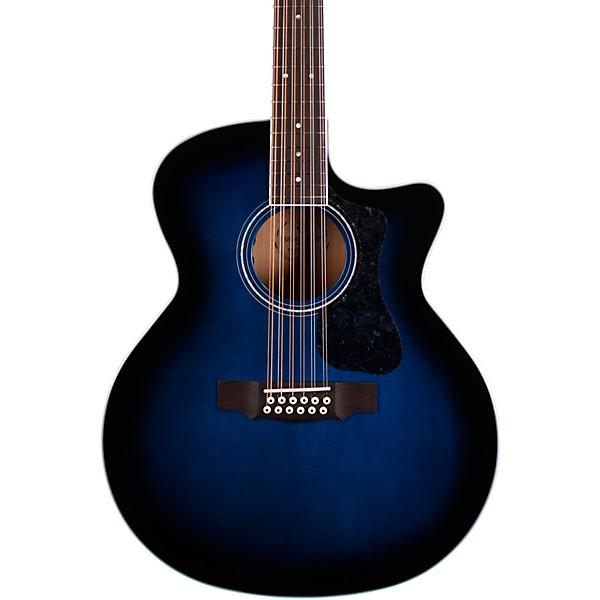
As we move further into our buying guide for Guild 12-string acoustic guitars, let’s talk about some price considerations. It’s important to understand that 12-string guitar pricing varies based on several factors – model and type, materials used in construction, age, and even the place of purchase to name a few.
As someone who’s made a career out of guitars, trust me when I say that understanding these factors can significantly impact the cost you’ll incur, and ultimately, your overall satisfaction with the instrument. It’s why I’ve always insisted on doing my homework on guitar pricing before making a purchase.
An entry-level Guild 12-string may set you back upwards of a thousand dollars, while high-end models can go over the five-thousand-dollar mark. Keep in mind, though, that a higher price tag doesn’t necessarily mean better quality sound or playability. It’s about finding a guitar that fits your personal taste and playing style.
Moving onto our next topic, ‘New vs Used Guitars’, remember the cost implications we discussed in this section. They can help you make a more informed decision about whether investing in a new Guild 12-string or a pre-owned one is right for you.
Best Places to Buy
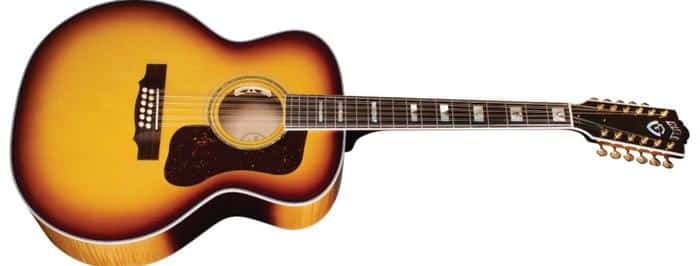
Entering into the final section of our comprehensive guide, let me spotlight the relevance of meticulously selecting where to purchase your Guild 12-string guitar. Based on personal experience and extensive research, a customer-centric vendor prioritising quality, authenticity, and service is key.
Buying a Guild 12-string guitar is not an everyday purchase and the place you buy it from matters significantly. Through my journey in the world of music, I’ve interacted with various vendors and my experiences range widely. Some acclaimed stores disappointed whereas lesser-known, local shops provided excellent service and exceptional instruments. Every experience was a learning opportunity about the importance of research and judgement in making the best choice.
I advise approaching well-recognised stores with due diligence, while also not overlooking the potential of smaller, local vendors. It’s imperative to evaluate their reputation, verify authenticity of the guitars, and assess after-sales services before making a decision.
In the spirit of sharing, I’ll delve into some of my recommended places to buy in the next section, drawing from my past experiences and years spent in the community of guitar enthusiasts. In no time, your dream Guild 12-string acoustic guitar will be within reach.
Maintenance of Guild 12-string Acoustic Guitars

As someone deeply passionate about my guitars, maintaining my instruments has always been crucial to me. Sharing that passion and knowledge is equally important to me. This is why I’m going to talk you through the do’s and don’ts of Guild 12-string guitar maintenance. These are not just any guitars – these are instruments that sparkle with a charm and charisma, bringing your music to life in ways unimaginable.
How can you ensure the longevity of your Guild 12-string guitar with regular maintenance? Well, this question segues seamlessly into the heart of what we’ll be discussing, and it’s a question that’s etched deep in my heart.
Firstly, a regular clean is essential. Always use a soft, dry cloth to gently remove any grime or dust from the instrument. Never use a damp cloth; moisture can very quickly become your guitar’s worst enemy. Additionally, be sure to use specialty wood polish that’s intended for guitars. Such polishes not only clean but also condition the wood of your instrument, ensuring long term health and sound quality.
Another important point in Guild 12-string guitar maintenance is climate control. The very nature of wood and how it reacts to humidity and temperature changes means these elements can significantly impact your guitar. Therefore, storing your Guild 12-string in a hard-shell case and using a humidifier when needed can create a favourable environment for the instrument.
Lastly, believe it or not, changing your strings plays a huge part in maintaining your guitar. From personal experience, I can tell you not to underestimate the transformational power of fresh strings. Not only do they keep the guitar sounding vibrant and rich, but they also reduce the strain on the guitar’s neck, contributing to its longevity.
Ultimately, the care and love you hold for your Guild 12-string guitar will show in its sound, performance, look, and enduring presence. Caring for it isn’t just about dusting it off and changing its strings. It’s about understanding and respecting the instrument’s construction, characteristics, and needs. Adhere strictly to these maintenance practices, and you’ll enjoy the mesmerizing music of your Guild 12-string for years to come.
FAQs
What makes Guild 12-string acoustic guitars unique?
Guild 12-string acoustic guitars are known for their superior sound quality, craftsmanship and exceptional playability. The 12 strings create richer, more layered music that is distinct from the standard 6-string guitars. Guild guitars stand out because of their focus on structural integrity, which ensures longevity and consistent tone.
How do different models of Guild 12-string acoustic guitars compare?
Different models of Guild 12-string guitars have unique features that cater to varying preferences. For instance, the F-512 model is revered for its jumbo shape and produces a full-bodied and powerful tone. The F-412 model, while similar to F-512, has a slightly smaller body leading to more tonal clarity. The custom-made models allow for personalized adjustments and modifications to meet the specific needs of the guitarists.
What materials are used in the construction of Guild 12-string acoustic guitars?
Guild 12-string acoustic guitars are typically made using premium tonewoods for construction. The top is usually solid Sitka spruce, known for its superior resonance. The back and sides can be made from a variety of woods such as rosewood, mahogany, or maple, each with their unique tonal properties. The neck is typically crafted from mahogany, with a rosewood fretboard.
Conclusion
So, what is the final verdict on Guild 12-string acoustic guitars, and is it the right fit for your musical journey? Having strummed all the strings and played all the notes, it’s time to recap our in-depth exploration. Drawing upon my personal experiences, I can testify that these instruments encapsulate a unique blend of history, craftsmanship, playability and most importantly, unparalleled sound quality.
The nuances of the Guild 12-string’s construction offer a generous palette of tonal variation, while its playability offers an inviting experience for both beginner and pro guitarists. If you’re seeking a guitar with a resonating and lush sound, this could certainly be the right choice.
Compared to other brands, Guild holds its own, shining particularly in terms of sound quality and durability. Your choice of purchasing new or used will depend on factors such as budget, preference, and the model you’re eyeing. Forums and user reviews are a valuable resource in this regard.
Maintenance of your Guild 12-string guitars is key to longevity, and sourcing from reputed outlets is crucial. Ultimately, your musical preference and player-specific needs will decide the perfect fit. But rest assured, with a Guild 12-string in hand, the melody is always rich and the journey, memorable.
